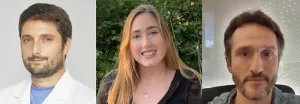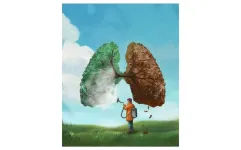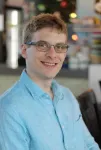(Press-News.org) Some neurological disorders can be improved through photobiomodulation, a non-invasive technique based on the application of low-intensity light to stimulate altered functions in specific regions of the body. Now, a study published in the Journal of Affective Disorders reveals how photobiomodulation applied to the brain-gut axis is effective in recovering some cognitive alterations and sequelae caused by chronic stress. The study opens up new perspectives for applying the technique in future therapies for the treatment of neurological diseases in patients.
The article, based on the study of laboratory animal models, is led by Professor Albert Giralt, from the Faculty of Medicine and Health Sciences and the Institute of Neurosciences (UBneuro) of the University of Barcelona. Teams from the UB’s Centre for the Production and Validation of Advanced Therapies (CREATIO) and the University of Girona, as well as from the University of Montpellier and the company REGEnLIFE (France) are also participating.
Low-intensity light for activating the gut-brain axis
In clinical practice, photobiomodulation applies light from lasers or other low-intensity sources to stimulate the activity of an organ with an altered physiology. Now, the new study applies, for the first time in the field of depression, the use of combined photobiomodulation to stimulate different organs, specifically the brain and the gut.
“This is one of the most innovative scientific contributions of the study: to co-stimulate in a coordinated way the brain and the gut at the same time, i.e. the gut-brain axis. Today, the area of research into the gut-brain axis is generating great scientific interest and is a very promising field for the possible treatment of diseases of the nervous system”, says Professor Albert Giralt, member of the August Pi i Sunyer Biomedical Research Institute (IDIBAPS) and the Network Centre for Biomedical Research on Neurodegenerative Diseases (CIBERNED).
“The new therapeutic approach focuses on this now rediscovered scenario of intervention and manipulation of the gut-brain axis to address neurological and psychiatric disorders”, says Giralt. “Photobiomodulation is a non-invasive technology that is very well tolerated by patients and lacks the side effects of pharmacological treatments. In addition, this advance could also be useful in the treatment of pathologies without clear or incomplete medical coverage, such as the treatment-resistant subtype of depression”, adds the expert.
The devices for the application of photobiomodulation, developed by the company REGEnLIFE, have been adapted from previous studies related to Alzheimer’s patients. They combine multiple stimulation sources (laser, LED, etc.) associated with a magnetic ring to stabilise the emission of light in a pulsed — and not continuous — manner to avoid overheating the tissues, and are adapted for clinical application in patients.
Psychiatric disorders: beyond the brain
Another scientific objective of the study is to prove that psychiatric disorders are not only centred in the brain, “but that other tissues and organs also play a decisive role in their pathophysiology. If new therapies take all these factors into account, it is very likely that we will be able to obtain very satisfactory results in the future”, says the researcher.
But do both photobiomodulation and photobiomodulation act on the cervical-intestinal axis? To date, there have only been descriptive studies of the modifications induced by photobiomodulation. Now, the study delves into the molecular mechanisms and reveals how photobiomodulation is able to reverse the cognitive effects of chronic stress by restoring the sirta1 pathway, “related to senescence and neuronal death, the modulation of negative pyramiding and normalisation of diversity in the intestinal microbiota”, notes researcher Anna Sancho-Balcells (UB-UBneuro-CIBERNED), first author of the article.
“From other studies — she continues — it was known that the SIRT1 pathway is altered in preclinical models of stress and depression. However, the mechanisms by which photobiomodulation exerts its beneficial effects remained a mystery. In our study, we found that the SIRT1 pathway is the most altered physiological pathway in certain brain regions under chronic stress, and photobiomodulation has the capacity to restore it”.
In the digestive system, photobiomodulation would activate changes in the intestinal microbiota, effects that are superior in the case of dual brain-gut stimulation compared to treatment of the gut alone. As Professor Xavier Xifró, from the TargetsLab research group at the Faculty of Medicine of the University of Girona, explains, “the associated cellular mechanisms seem to be linked to the improvement of neuroinflammatory processes. Thus, the changes observed in the microbiota are strongly associated with some changes in neuroinflammation (for example, microgliosis and astrogliosis, which occur through the inflammation of specific cells of the nervous system)”.
Combined photobiomodulation in patients with depression
Photobiomodulation could become a potential adjunctive treatment to be administered in coordination with pharmacological therapy in cases of major depressive disorders. In future research, the team would like to promote the design of clinical trials to test the efficacy of combined photobiomodulation in patients with depression.
“Photobiomodulation is likely to be particularly suitable for specific forms of depression, such as treatment-resistant depression. We also want to explore the relationship with neuroinflammatory processes: this is one of the best-rescued parameters after photobiomodulation and treatment-resistant depression is strongly associated with neuroinflammation”, concludes the research team.
END
Low intensity light to fight the effects of chronic stress
Psychiatric disorders: beyond the brain
2024-05-02
ELSE PRESS RELEASES FROM THIS DATE:
Wildfires in wet African forests have doubled in recent decades
2024-05-02
American Geophysical Union
Press Release 24-19
2 May 2024
For Immediate Release
This press release is available online at: https://news.agu.org/press-release/africa-forest-fires-doubled-drying
Wildfires in wet African forests have doubled in recent decades
Climate change and human activities like deforestation are causing more fires in central and west Africa’s wet, tropical forests, according to the first-ever comprehensive survey there. The fires have long been overlooked.
AGU press contact:
Rebecca Dzombak, news@agu.org (UTC-4 hours)
Contact information ...
Dietary changes may treat pulmonary hypertension
2024-05-02
Blood vessels in the lungs aren’t like the others in the body. This difference becomes clear in pulmonary hypertension, in which only the lungs’ blood vessels stiffen progressively, leading to chronic lung disease, heart failure and death. The underlying reasons for this organ-specific vessel stiffening remained a mystery until University of Pittsburgh researcher Stephen Chan and colleagues made a surprising discovery about these blood vessel cells in patients with pulmonary hypertension—they’re hungry.
Chan, Vitalant Chair in Vascular Medicine and Professor of Medicine in the Division ...
UTA scientists test for quantum nature of gravity
2024-05-02
Einstein’s theory of general relativity explains that gravity is caused by a curvature of the directions of space and time. The most familiar manifestation of this is the Earth’s gravity, which keeps us on the ground and explains why balls fall to the floor and individuals have weight when stepping on a scale.
In the field of high-energy physics, on the other hand, scientists study tiny invisible objects that obey the laws of quantum mechanics—characterized by random fluctuations that create ...
SCAI announces recipients of 2024 early career research grants
2024-05-02
Today, the Society for Cardiovascular Angiography & Interventions (SCAI) announced the recipients of the 3rd Annual SCAI Early Career Research Grants. SCAI offers this initiative to support the next generation of interventional cardiologists, providing a platform for junior-level investigators within 10 years of completing an interventional cardiology fellowship to study high-priority, clinically important topics and have their findings disseminated through various professional channels. This year’s grants are funded by support from Edwards Lifesciences, Medtronic, and Shockwave Medical.
“Research funding is often ...
AI can tell if a patient battling cancer needs mental health support
2024-05-02
Researchers at UBC and BC Cancer have developed a new artificial intelligence (AI) model that can accurately predict if a person receiving cancer care will require mental health services during their treatment journey.
The AI uses natural language processing and advanced neural networks to analyze an oncologist’s notes from their first consultation appointment with a patient. While these appointments are typically highly focused on a patient’s medical history and treatment options, the AI picks ...
ISSCR announces Hong Kong, SAR as location for its 2025 Annual Meeting
2024-05-02
The world’s leading stem cell scientists will convene in Hong Kong, SAR, 11-14 June 2025 for the International Society for Stem Cell Research (ISSCR) 2025 Annual Meeting, illuminating the future of stem cell science and highlighting the most compelling research and clinical advances of the year. The meeting is co-sponsored by The University of Hong Kong, The Chinese University of Hong Kong, and Hong Kong University of Science and Technology. The Hong Kong Innovation and Technology Commission and the Hong Kong Convention and Exhibition Centre provided significant support to enable the ISSCR to bring its hallmark event to the city of ...
Zoology: First report of wound treatment by a wild animal using a medicinal plant
2024-05-02
A wild male Sumatran orangutan (Pongo abelii) has been observed applying chewed leaves from Akar Kuning (Fibraurea tinctoria) — a climbing plant used in traditional medicine to treat wounds and conditions such as dysentery, diabetes, and malaria — to a wound on his cheek. The findings, which are published in Scientific Reports, represent the first report of suspected wound treatment by a wild animal using a plant with known medicinal properties.
Prior to this study, multiple ...
Longer interval between first colonoscopy with negative findings for colorectal cancer and repeat colonoscopy
2024-05-02
About The Study: This cohort study found that for the population without a family history of colorectal cancer (CRC), the 10-year interval between colonoscopy screenings for individuals with a first colonoscopy with findings negative for CRC could potentially be extended to 15 years. A longer interval between colonoscopy screenings could be beneficial in avoiding unnecessary invasive examinations.
Authors: Mahdi Fallah, M.D., Ph.D., of the German Cancer Research Center in Heidelberg, is the corresponding ...
Smoking cessation after initial treatment failure with varenicline or nicotine replacement
2024-05-02
About The Study: For individuals who smoked but did not achieve abstinence after treatment with varenicline, increasing the dosage enhanced abstinence versus continuing, whereas for nonabstainers initially treated with combined nicotine replacement therapy, a dosage increase or switch to varenicline enhanced abstinence and may be viable rescue strategies.
Authors: Paul M. Cinciripini, Ph.D., of the University of Texas MD Anderson Cancer Center in Houston, is the corresponding author.
To access the embargoed study: Visit our For The Media website at this link https://media.jamanetwork.com/
(doi:10.1001/jama.2024.4183)
Editor’s Note: Please see the article ...
How the brain’s arousal center helps control visual attention too
2024-05-02
The locus coeruleus (LC) is a small region of the brainstem that produces norepinephrine, a chemical with powerful effects on arousal and wakefulness which plays an important role in the body’s response to stress or panic. Now, research from the University of Chicago shows it plays a specific role in visual sensory processing as well.
In a new study published in Neuron, neuroscientists artificially increased neuronal activity in the LC by briefly shining light on genetically modified neurons. They saw that this manipulation selectively enhanced performance in non-human primates performing a visual attention task, underscoring the crucial role that attention plays in sensory ...
LAST 30 PRESS RELEASES:
An ‘illuminating’ design sheds light on cholesterol
Who is more likely to get long COVID?
Study showcases resilience and rapid growth of “living rocks”
Naval Research Lab diver earns Office of Naval Research 2025 Sailor of the Year
New Mayo-led study establishes practical definition for rapidly progressive dementia
Fossil fuel industry’s “climate false solutions” reinforce its power and aggravate environmental injustice
Researchers reveal bias in a widely used measure of algorithm performance
Alcohol causes cancer. A study from IOCB Prague confirms damage to DNA and shows how cells defend against it
Hidden viruses in wastewater treatment may shape public health risks, study finds
Unlock the power of nature: how biomass can transform climate mitigation
Biochar reshapes hidden soil microbes that capture carbon dioxide in farmland
Reducing saturated fat intake shows mortality benefit, but only in high-risk individuals
Manta rays create mobile ecosystems, study finds
Study: Mixed results in using lipoic acid to treat progressive multiple sclerosis
Norbert Holtkamp appointed director of Fermi National Accelerator Laboratory
New agentic AI platform accelerates advanced optics design
Biologists discover neurons use physical signals — not electricity — to stabilize communication
Researchers discover that a hormone can access the brain by hitchhiking
University of Oklahoma researcher awarded funding to pursue AI-powered material design
Exploring how the visual system recovers following injury
Support for parents with infants at pediatric check-ups leads to better reading and math skills in elementary school
Kids’ behavioral health is a growing share of family health costs
Day & night: Cancer disrupts the brain’s natural rhythm
COVID-19 vaccination significantly reduces risk to pregnant women and baby
The role of vaccination in maternal and perinatal outcomes associated with COVID-19 in pregnancy
Mayo Clinic smartwatch system helps parents shorten and defuse children's severe tantrums early
Behavioral health spending spikes to 40% of all children’s health expenditures, nearly doubling in a decade
Digital cognitive behavioral treatment for generalized anxiety disorder
Expenditures for pediatric behavioral health care over time and estimated family financial burden
Air conditioning in nursing homes and mortality during extreme heat
[Press-News.org] Low intensity light to fight the effects of chronic stressPsychiatric disorders: beyond the brain






